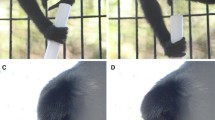Abstract
The debate over nonhuman primate precursors to human handedness is unsettled mainly due to lack of data, particularly on apes. Handedness in wild chimpanzees at the Taï National Park Côte d'Ivoire, has been monitored in four tasks. For the simple unimanual ones, reaching and grooming, adults use both hands equally (ambidextrous), while for the more complex unimanual wadge-dipping and the complex bimanual nut-cracking, adults are highly lateralized. These results support the hypothesis that lateralization increases with the complexity of the task. The lateralization is constant for years for each task but may vary in an individual with respect to different tasks. For nutcracking females are more lateralized than males. The ontogeny of handedness for nut-cracking shows many variations in the tendency to use one hand and in the side preferred, until at about 10 years of age, the individual achieves her adult handedness. No population bias toward one side exists in Taï chimpanzees. No heritability of handedness between mother and offspring was observed. Human and chimpanzees handedness are compared.
Similar content being viewed by others
References
Annet, M. (1987). Handedness as chance or as species characteristic.Behav. Brain Sci. 10(2): 263–264.
Boesch, C., and Boesch, H. (1983). Optimization of nut-cracking with natural hammers by wild chimpanzees.Behaviour 83: 265–286.
Boesch, C. and Boesch, H. (1984a). Mental map in wild chimpanzees: An analysis of hammer transports for nut cracking.Primates 25: 160–170.
Boesch, C., and Boesch, H. (1984b). Possible causes of sex differences in the use of natural hammers by wild chimpanzees.J. Hum. Evol. 13: 415–440.
Bresard, F., and Bresson, F. (1983) Handedness in Pongo and Pan troglodytes.J. Hum. Evol. 12: 59–66.
Bryden, M. P., and Steenhuis R. E. (1987). Handedness is a matter of degree.Behav. Brain Sci. 10(2): 266–267.
Calvin, W. (1987) On evolutionary expectations of symmetry and toolmaking.Behav. Brain Sci. 10(2): 267–268.
Fagot, J., and Vauclair, J. (1991) Manual laterality in nonhuman primates: A distinction between handedness and manual specialization,Psychol. Bull. 109(1): 76–89.
MacNeilage, P., Studdert-Kennedy, M., and Lindblom, B. (1987) Primate handedness reconsidered.Behav. Brain Sci. 10(2): 247–263.
Marchant, L. F., and Steklis, H. D. (1986) Hand preference in a captive island group of chimpanzees (Pan troglodytes).Am. J. Primatol. 10: 301–13.
Nishida, T., and Hiraiwa, M. (1982) Natural history of a tool-using behaviour by wild chimpanzees in feeding upon wood-boring ants.J. Hum. Evol. 11: 73–99.
Siegel, S., and Castellan, N. J. (1988)Nonparametric Statistics for the Behavioral Sciences, McGraw-Hill, New York.
Warren, J. M. (1980). Handedness and laterality in humans and other animals.Phys. Psychol. 8: 351–359.
Warren, J. M. (1987) Primate handedness: Inadequate analysis, invalid conclusions.Behav. Brain Sci. 10(2): 288–289.
Author information
Authors and Affiliations
Rights and permissions
About this article
Cite this article
Boesch, C. Handedness in wild chimpanzees. International Journal of Primatology 12, 541–558 (1991). https://doi.org/10.1007/BF02547669
Received:
Accepted:
Issue Date:
DOI: https://doi.org/10.1007/BF02547669




